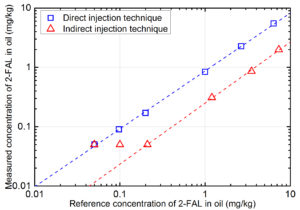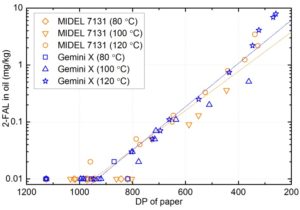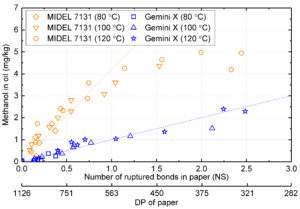The world’s first synthetic ester filled 400 kV, 240 MVA power transformer is to be connected to the UK transmission network, a great achievement in the perspective of going ‘green’ with the power system. At the same time, it might be a challenge to the asset managers for managing such transformers as their behaviour and condition assessment criteria could be different from mineral oil filled transformers.
With a growing number of ester filled large high voltage power transformers, concerns have been raised on assessing the ageing state of these transformers. The molecular structure of ester based liquids is apparently different from mineral oils and hence esters are likely to behave differently from the conventional mineral oils in certain aspects. In addition, the concentration of chemical indicators such as moisture and acids in ester liquids could be different from those in mineral oils, which makes it difficult to use the same condition monitoring criteria used for mineral oil filled transformers to assess the ester filled transformers.
Due to the difficulties in obtaining paper samples from transformers in-service, the ageing state of the paper insulation in transformers is commonly assessed through chemical markers in oils that are generated from paper ageing. Furanic compounds, carbon oxide gases are the conventional paper ageing indicators. In addition recent research has shown the possibility of using methanol as a paper ageing indicator. It has been found that the esters themselves could produce a high amount of carbon oxide gases causing difficulties in adopting carbon oxide gases to predict paper aging in esters. Furthermore, only a few experiments have been conducted on furanic compounds in esters and the concentrations in synthetic esters reported in some previous work were exceptionally low compared with that in mineral oils.
This article investigates the applicability of 2-FAL and methanol as chemical markers for non thermally upgraded paper insulation impregnated with synthetic esters through laboratory ageing experiments
Measurement of 2-FAL in synthetic esters
Currently there isn’t a standard procedure for measuring 2-FAL in synthetic esters. Hence the applicability of standards available for mineral oil BS EN 61198 and ASTM D5837, which are based on using high performance liquid chromatography (HPLC) was investigated. The BS EN 61198 standard recommends an indirect injection technique during which the furanic compounds are extracted from oil prior to the injection through either liquid-liquid or solid-liquid extraction whereas, the ASTM D5837 standard recommends either the same indirect injection technique or a direct injection of oil into the system.

Measurements conducted through the direct injection technique were similar to the reference values whereas those obtained through the indirect injection technique were about four times lower than the reference value. The error in the indirect injection technique is due to a difference in the extraction efficiency of 2‑FAL between the synthetic ester and the mineral oil. This issue can be overcome by using a calibration curve prepared from the synthetic ester during the indirect injection measurements.
Measurement of methanol in synthetic esters
A standard technique for measuring methanol in transformer oil is under preparation (IEC PT 63025). There for an in-house method with a headspace gas chromatography mass spectrometry unit was used to measure methanol in transformer oil.
Results of the laboratory ageing experiments
Laboratory ageing of oil and paper samples was conducted with a mineral oil (Gemini X) and a synthetic ester (MIDEL 7131). Variation of 2-FAL and methanol in synthetic ester and in mineral oil against the paper ageing level is shown in the figures below.


It can be seen that the variation of 2-FAL in synthetic ester is similar to that of mineral oil. However, methanol in the synthetic ester was different from that in mineral oil. For same paper ageing level methanol in the synthetic ester was higher than that in mineral oil. Partitioning experiments conducted with mineral oil and synthetic esters confirmed that the difference in the partitioning of methanol between oil and paper has resulted in the difference concentration of methanol in synthetic ester from mineral oil. Therefore, it is important to consider the partitioning phenomena when moving from laboratory scale experiments to in-service measurement.
This is an important topic for both researchers and industry. Have you done similar analysis to identify the differences between natural esters and synthetic esters ?
Thank you for the comment. No we haven’t compared the synthetic and natural esters. I believe natural esters will also hold more methanol than mineral oil due to their polar nature. It would be interesting to know how close or far it is to the synthetic ester.